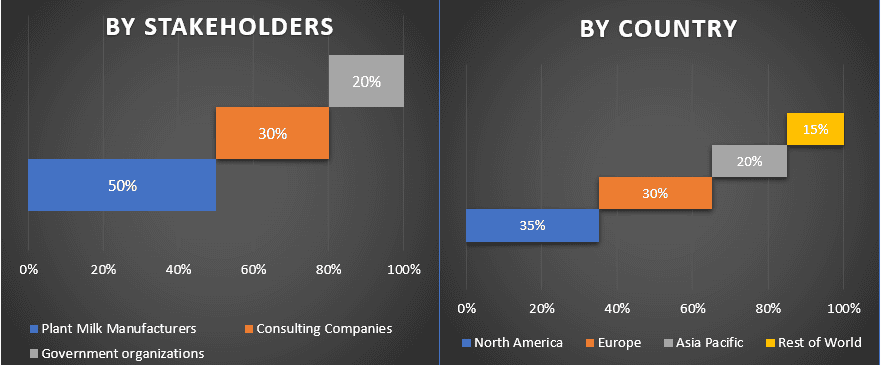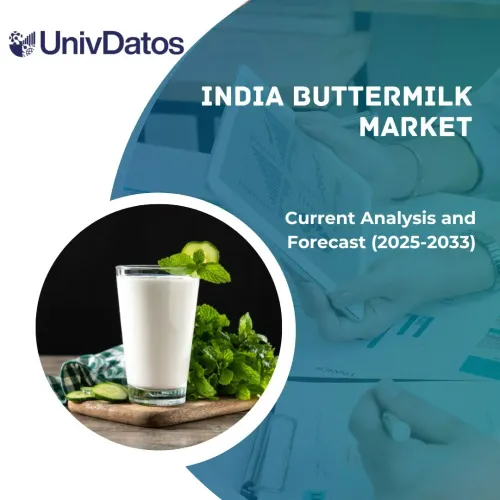- Home
- About Us
- Industry
- Services
- Reading
- Contact Us
Plant Milk Market: Current Analysis and Forecast (2021-2027)
Emphasis on Source (Almond, Soy, Coconut, Rice, Others); Formulation (Regular, Flavored); Nature (Organic, Conventional); Sales Channel (Supermarket/hypermarket, Online Stores, Specialty Stores, Convenience Store, Others); Region/Country

The Global Plant Milk is Expected to Display an Elevated CAGR of ~10% over the forecast period (2021-2027)
A rising shift towards a vegan diet and emerging economics provide significant growth opportunities for plant-based milk manufacturers. As per Veganbits, 7.53 billion vegan people are living worldwide, out of which, 1.2 billion people are living in Africa. People are drawn to vegetarianism for a multitude of reasons, some of which include religion, ethical motivation, health, environmental conservation, economic factors, dislike of meat, and culture. Consuming plant-based foods is just a trend for Millennials and younger generations. Millennials and Gen Z make up 30-32% of the population, respectively, creating the enormous market potential for plant-based foods. As per Nielsen, 85% of Canadians and 83% of United States people are preferring plant-based food over animal-based food
In Europe, consumption of plant-based meat substitutes made up 40% of the world market in 2019 and is forecast to grow by 60% through 2025, mainly due to concerns for health, food security, and animal welfare. In the U.S. during 2019, the retail market for plant-based foods grew eight times faster than the general retail food market
1/3 of Americans are actively reducing their meat and dairy consumption. A new study by Ipsos Retail has revealed that the number of Americans following plant-based diets is up nearly 9.6 million over the last 15 years. This is a 300% increase and nearly 3 %of the population in the United States. This increase in the vegan population is expected to drive the plant-based protein market. As per the Plantproteins.co, U.S. retail sales of plant-based foods have increased 11 percent from 2018 to 2019, hitting a plant-based market value of $4.5 billion.
Nutritional Profile for Different Types of Milk (Per 100 ml of product)

Groupe Danone, Pacific Foods of Oregon, Inc., The Hain Celestial Group Inc., Turtle Mountain LLC, Vitasoy International Holdings Limited., Natura Foods, Freedom Foods Group Ltd., Earth’s Own Food Company Inc., Mc Cormick & Co., The Hershey Co, etc., are some of the prominent players operating in the Plant Milk market. Several M&As along with partnerships have been undertaken by these players to facilitate customers with hi-tech and innovative products.
Insights Presented in the Report
“Amongst source, Soy Plant Milk segment holds the major share”
Based on the source, the market is fragmented into Almond, Soy, Coconut, Rice, and Others. The soy plant Milk segment grabbed the major market share and dominated the market in 2020. The market of this segment would reach USD XX Mn by 2027. The growing awareness about the health benefits of soy milk among consumer is leading to the growing demand for this segment, As per American Heart Association, eating foods containing soy protein to replace foods high in animal fats have benefits to cardiovascular health.
“Amongst formulation, flavored segment to grab considerable market share”
Based on the formulation, the market is fragmented into Regular and Flavored. The regular segment grabbed XX% market share and captured USD XX Mn market in 2020. However, the flavored segment would witness the robust CAGR during the forthcoming years
“Amongst nature, organic segment to grab considerable market share in forthcoming years”
Based on the nature, the market is segmented into Organic and Conventional. The conventional segment grabbed the major market share and dominated the market. However, with the rising disposable income and surging awareness, the demand for organic milk is witnessing an uptick.
“Amongst sales channel, hypermarket/ supermarket segment to grab considerable market share”
Based on the distribution channel, the market is fragmented into Supermarkets and Hypermarkets, Specialty Stores, Convenience Stores, Online Stores, and Others. The supermarkets and hypermarkets segment grabbed XX% market share and captured USD XX Mn market in 2020. However, the online store segment would witness a robust CAGR during the forthcoming years
“Asia-Pacific represents one of the largest markets of Plant Milk market”
For a better understanding of the market dynamics of the Plant Milk market, a detailed analysis was conducted for different regions across the globe including North America, Europe, Asia Pacific, and the Rest of the world. Asia-Pacific region dominated the market and generated the leading revenue share in 2020 owing to rising disposable income and emerging demand from lactose-intolerant people.
Reasons to buy this report:
- The study includes market sizing and forecasting analysis validated by authenticated key industry experts
- The report presents a quick review of overall industry performance at one glance
- The report covers an in-depth analysis of prominent industry peers with a primary focus on key business financials, product portfolio, expansion strategies, and recent developments
- Detailed examination of drivers, restraints, key trends, and opportunities prevailing in the industry
- The study comprehensively covers the market across different segments
- Deep dive regional level analysis of the industry
Customization Options:
The Plant Milk Market can further be customized as per the requirement or any other market segment. Besides this, UMI understands that you may have your own business needs, hence feel free to connect with us to get a report that completely suits your requirements.
Table of Content
Analyzing the historical market, estimation of the current market, and forecasting the future market of the Plant Milk Market were the three major steps undertaken to create and analyze the demand for Plant Milk across major regions. Exhaustive secondary research was conducted to collect the historical market numbers and estimate the current market size. Secondly, to validate these insights, numerous findings and assumptions were taken into consideration. Moreover, exhaustive primary interviews were also conducted, with industry experts across the value chain of the Plant Milk market. Post assumption and validation of market numbers through primary interviews, we employed a top-down/ bottom-up approach to forecast the complete market size. Thereafter, market breakdown and data triangulation methods were adopted to estimate and analyze the market size of segments and sub-segments the industry pertains to. Detailed methodology is explained below:
Analysis of Historical Market Size
Step 1: In-Depth Study of Secondary Sources:
Detailed secondary study was conducted to obtain the historical market size of the Plant Milk through company internal sources such as annual reports & financial statements, performance presentations, press releases, etc., and external sources including journals, news & articles, government publications, competitor publications, sector reports, third-party database, and other credible publications.
Step 2: Market Segmentation:
After obtaining the historical market size of the Plant Milk market, we conducted a detailed secondary analysis to gather historical market insights and share for source, type, form, sales channel for major regions. Major segments included in the report are type and sales channel. Further region and country-level analyses were conducted to evaluate the overall adoption of Plant Milk across the globe.
Step 3: Factor Analysis:
After acquiring the historical market size of different segments and sub-segments, we conducted a detailed factor analysis to estimate the current market size of the Plant Milk. Further, we conducted factor analysis using dependent and independent variables such as the rising disposable income, surging demand from the lactose-intolerant people, etc., A thorough analysis was conducted for demand and supply-side scenarios considering top partnerships, merger and acquisition, business expansion, and product launches in the Plant Milk industry across the globe.
Current Market Size Estimate & Forecast
Current Market Sizing: Based on actionable insights from the above 3 steps, we arrived at the current market size, key players in the Plant Milk market, and market shares of the segments. All the required percentage shares split, and market breakdowns were determined using the above-mentioned secondary approach and were verified through primary interviews.
Estimation & Forecasting: For market estimation and forecast, weightage was assigned to different factors including drivers & trends, restraints, and opportunities available for the stakeholders. After analyzing these factors, relevant forecasting techniques i.e. bottom-up/ top-down approach was applied to arrive at the market forecast about 2027 for different segments and subsegments across the major markets globally. The research methodology adopted to estimate the market size encompasses:
- The industry’s market size, in terms of value (US$) and the adoption rate of Plant Milk across the major markets domestically
- All percentage shares, splits, and breakdowns of market segments and sub-segments
- Key players in the Plant Milk market in terms of services offered. Also, the growth strategies adopted by these players to compete in the fast-growing market
Market Size and Share Validation
Primary Research: In-depth interviews were conducted with the Key Opinion Leaders (KOLs) including Top Level Executives (CXO/VPs, Sales Head, Marketing Head, Operational Head, and Regional Head, Country Head, etc.) across major regions. Primary research findings were then summarized, and statistical analysis was performed to prove the stated hypothesis. Inputs from primary research were consolidated with secondary findings, hence turning information into actionable insights.
Split of Primary Participants in Different Regions

Market Engineering
Data triangulation technique was employed to complete the overall market estimation and to arrive at precise statistical numbers of each segment and sub-segment of the Plant Milk market. Data was split into several segments sub-segments post studying various parameters and trends in the areas of source, type, form, the sales channel of the Plant Milk market.
Main Objective of the Plant Milk Market Study
The current & future market trends of Plant Milk were pinpointed in the study. Investors can gain strategic insights to base their discretion for investments from the qualitative and quantitative analysis performed in the study. Current and future market trends were determined the overall attractiveness of the market at a regional level, providing a platform for the industrial participant to exploit the untapped market to benefit as a first-mover advantage. Other quantitative goals of the studies include:
- Analyze the current and forecast market size of Plant Milk in terms of value (US$). Also, analyze the current and forecast market size of different segments and sub-segments
- Segments in the study include areas of source, type, form, sales channel
- Define and analysis of the regulatory framework for the Plant Milk industry
- Analyze the value chain involved with the presence of various intermediaries, along with analyzing customer and competitor behaviors of the industry
- Analyze the current and forecast market size of the Plant Milk market for the major countries
- The major region studied in the report includes North America, Europe, Asia- Pacific, and the Rest of the World.
- Company profiles of the Plant Milk market and the growth strategies adopted by the market players to sustain in the fast-growing market
- Deep dive regional level analysis of the industry
Related Reports
Customers who bought this item also bought










